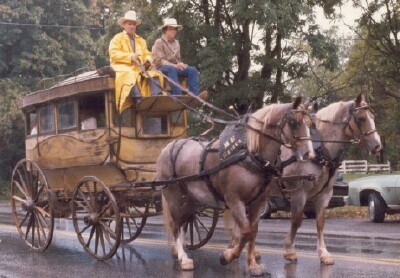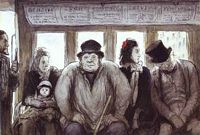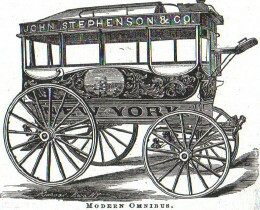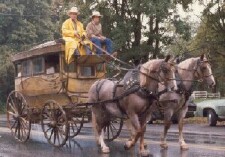The Monroe County West Virginia Omnibus
 Many years have passed since the Sweet Chalybeate horse-drawn
omnibus participated in parades or other events on the streets
of the county, as on the rainy day pictured here. More than
100 years have passed since it carried the guests of the Sweet
Chalybeate and the Old Sweet Springs to and from the Alleghany
Station on the C&O railway just over the border in Virginia.
Those were the days of its prime, when both resorts were busy
offering the reputed medicinal virtues of drinking from the
mineral springs and "taking the baths." Sadly, too few people
now living in Monroe County have ever seen or even know of this
treasure from their and America's past now in the care and
keeping of the Monroe County Historical Society. Our omnibus
had its origin not in Monroe county, but in the factory of John
Stephenson in New York City, where in 1827 Abraham Brower had
offered the first public cab service by providing horse-drawn
passage up and down Broadway between Wall Street and Bleecker
Street. One of Brower's first vehicles had narrow seats lining
the sides. Each seat could accommodate five or at most six
rather crowded passengers.
Many years have passed since the Sweet Chalybeate horse-drawn
omnibus participated in parades or other events on the streets
of the county, as on the rainy day pictured here. More than
100 years have passed since it carried the guests of the Sweet
Chalybeate and the Old Sweet Springs to and from the Alleghany
Station on the C&O railway just over the border in Virginia.
Those were the days of its prime, when both resorts were busy
offering the reputed medicinal virtues of drinking from the
mineral springs and "taking the baths." Sadly, too few people
now living in Monroe County have ever seen or even know of this
treasure from their and America's past now in the care and
keeping of the Monroe County Historical Society. Our omnibus
had its origin not in Monroe county, but in the factory of John
Stephenson in New York City, where in 1827 Abraham Brower had
offered the first public cab service by providing horse-drawn
passage up and down Broadway between Wall Street and Bleecker
Street. One of Brower's first vehicles had narrow seats lining
the sides. Each seat could accommodate five or at most six
rather crowded passengers.
 The accepted full occupancy was twelve. Since passengers could
enter at the open rear door as the horses moved slowly up Broadway,
it could get congested. In 1864 the artist Daumier gave us, in
a satiric crayon and watercolor picture entitled "The Omnibus,"
a view of the crowded interior of such a conveyance. At the
left in Daumier's picture, note the new arrival seeking room for
himself. (Click on the Daumier drawing for an enlarged image.)
The accepted full occupancy was twelve. Since passengers could
enter at the open rear door as the horses moved slowly up Broadway,
it could get congested. In 1864 the artist Daumier gave us, in
a satiric crayon and watercolor picture entitled "The Omnibus,"
a view of the crowded interior of such a conveyance. At the
left in Daumier's picture, note the new arrival seeking room for
himself. (Click on the Daumier drawing for an enlarged image.)
In 1831 John Stephenson (1809-1893), 22 years old, after only three years' apprenticeship to a carriage maker, started The John Stephenson Car Company, and began to build vehicles for Brower's Broadway service. Until the financial panic of 1837, both his and Brower's businesses grew rapidly. By 1833 Stephenson had a patent for a design that lowered the floor of the omnibus to make access easier. He would obtain numerous other patents for improvements to his vehicles. Although 1837 led to temporary bankruptcy, by 1845 he was back in business, and despite recurrent economic ups and downs became a leading producer of omnibuses--both road and rail--and later of railroad cars.

 Our omnibus is clearly similar to the one on page 460 of Ezra
Stratton's The World on Wheels(1878). The term "omnibus"
was first applied in 1828 in France to a long narrow coach labeled
voiture omnibus. The word was immediately accepted in
both England and the United States. By the 1860's the term "bus"
was coming into use, but was considered slangy. Today when we
refer to a bus we are probably unaware of where we got the word.
Our omnibus is clearly similar to the one on page 460 of Ezra
Stratton's The World on Wheels(1878). The term "omnibus"
was first applied in 1828 in France to a long narrow coach labeled
voiture omnibus. The word was immediately accepted in
both England and the United States. By the 1860's the term "bus"
was coming into use, but was considered slangy. Today when we
refer to a bus we are probably unaware of where we got the word.

